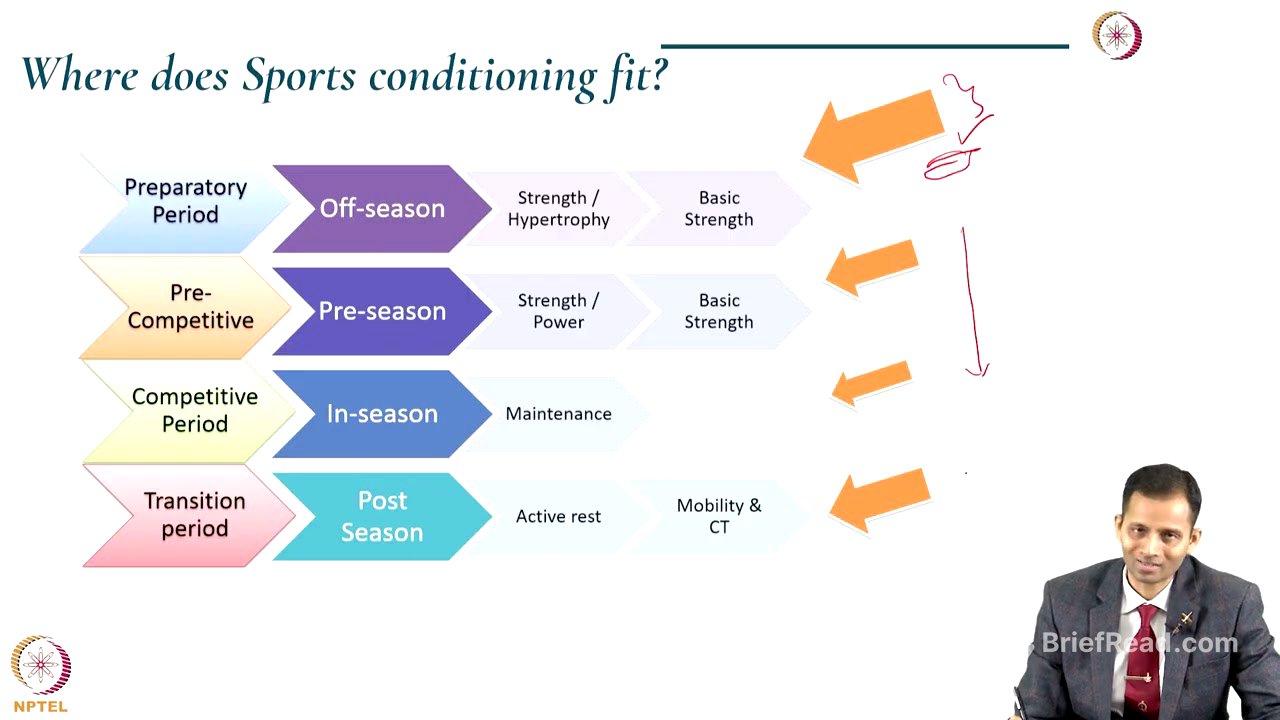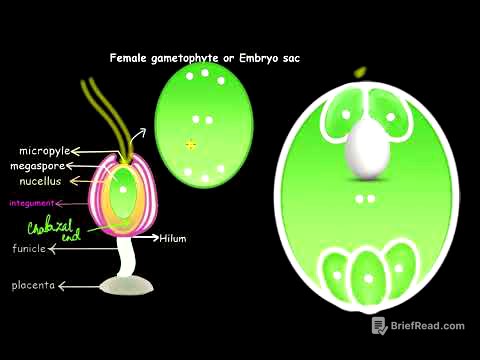TLDR;
This lecture provides an overview of sports conditioning, its purpose, and its integration with strength training periodization. It highlights the importance of sports conditioning in laying the foundation for any sports training program, emphasizing the development of basic motor qualities and preparing individuals for sport-specific training. The lecture also discusses the various components of a sports conditioning program, including aerobic training, speed and agility training, flexibility and mobility, resistance training, and balance and coordination, and how these components fit into different phases of a periodized training cycle.
- Sports conditioning lays the foundation for sports-specific training by developing basic motor qualities.
- Periodization involves sequencing and integrating training aspects to achieve peak performance and reduce burnout/injuries.
- Key components of sports conditioning include aerobic training, speed/agility, flexibility/mobility, resistance training, and balance/coordination.
Introduction to Sports Conditioning [0:15]
The lecture introduces the concept of sports conditioning and its role in enhancing sports performance. It outlines the learning objectives, which include understanding the purpose of sports conditioning, discussing its various components, integrating these components with strength training periodization principles, and incorporating a sports conditioning program into strength training sessions. The principles of sports training, including specificity, individuality, reversibility, progressive overload, and periodization, are highlighted as crucial for an effective training program that avoids plateaus, burnout, and injuries.
What is Sports Conditioning? [2:03]
Sports conditioning forms the base of any sports training program by addressing basic motor qualities, irrespective of the sport. It prepares the individual to endure sport-specific training. Periodization, a systematic process of sequencing and integrating training aspects, helps achieve peak performance, change training variables, and reduce the risk of burnout and injuries. The training cycle includes macro, meso, and micro cycles, with periodization involving offseason (strength and hypertrophy emphasis), preseason (sport-specific strength and power focus), competitive season (maintenance, peaking, and tapering), and postseason (active rest with mobility and cross-training).
Integrating Sports Conditioning into Periodization [4:45]
Sports conditioning plays a major role in the preparatory or offseason phase, laying the foundation for sport-specific training in pre-competitive and competitive phases. As an individual progresses to the preseason, the emphasis shifts to sport-specific drills, reducing the focus on basic motor qualities. During the competitive phase, the goal is to maintain adaptations, with minimal sports conditioning. The transition phase involves cross-training with low load and intensity, gradually increasing the role of sports conditioning again.
Components of a Sports Conditioning Program [7:15]
A conditioning program includes basic motor qualities such as aerobic training, speed and agility training, flexibility and mobility, resistance training, and balance and coordination. Flexibility refers to passive muscle length, while mobility involves active neuromuscular components in range of motion. Balance and coordination are important for motor control and neural adaptation, aiding muscular gains.
Aerobic Training [8:27]
Aerobic training is essential for almost every sport, aiding aerobic conditioning and store replenishment, even in power sports. It can be used as a concurrent training method. The focus of aerobic training should be mainly in the preparatory or offseason phase to develop cardiorespiratory fitness. Training methods depend on the sport, such as interval training, Fartlek, maximum aerobic speed training, and cross-training for distance runners. Cross-training is also important in sports injury rehabilitation, allowing cardiovascular fitness improvement while protecting the injured part.
Speed and Agility Training [11:56]
Speed and agility training maintains running speed, improves technique and efficiency, and enhances change of direction and reaction. It features more in the preparatory phase, but agility drills are also important in the pre-competitive phase for sports like football. Training methods correct technique and movement patterns, incorporated as skill training in warm-ups. Movement patterns should be corrected during the preparatory phase for neural adaptation. Speed interval training and agility drills with decision-making can be included.
Flexibility and Mobility [14:37]
Flexibility and mobility increase range of motion, decrease muscle stiffness, and improve neuromuscular coordination, preventing injury and aiding recovery. It can be part of warm-up or cool-down sessions, with a major focus in the preparatory phase to address joint range of motion limitations. It can also be incorporated in the transition phase for relaxation. Training methods include dynamic stretching in warm-ups, static stretching in cool-downs, and proprioceptive neuromuscular facilitation (PNF) for better range of motion increase. In injury rehabilitation, flexibility and mobility training are used in phase one.
Resistance Training [17:57]
Resistance training corrects muscular imbalances and asymmetries, improving basic strength for sport-specific strength development. The type of quality (endurance, hypertrophy, power) can be decided based on the conditioning program. It plays a major role in injury rehabilitation. Periodization involves planning strength training over a training cycle, using various methods for basic strength and modulating volume, rest intervals, and load. For rehabilitation, start with isometric, progress to concentric, eccentric, and then plyometric activities. The preparatory phase involves strength and hypertrophy with low to moderate load and high volume, gradually decreasing volume and increasing intensity as training progresses.
Balance and Coordination Training [20:00]
Balance and coordination training improves neuromuscular control, preventing injury and aiding rehabilitation. It is emphasized in the preparatory phase and forms a main part of the transition phase to address deficits. In injury rehabilitation, it is crucial from the later part of phase one and phase two, reducing the risk of reinjury. Progression involves moving from simple to complex tasks, such as single stance with eyes open to single stance with mobile platform and catching a ball.
Common Errors and Case Scenario [21:28]
Common errors in conditioning programs include generic programs with little attention to individual variation, ignoring sports demands, lack of monitoring, and overtraining. A case scenario involving a college basketball player with no prior training is discussed. The approach involves assessing the athlete profile (present status, training age, injury history), understanding sports needs (strength goals, position demands), and planning an annual training cycle. A sports conditioning program lasting 6-8 weeks can start with aerobic conditioning, incorporate mobility and flexibility, basic strength training, and progress to speed and agility drills towards the end.
Summary [25:10]
Sports conditioning lays the basic foundation for sports-specific programs, preparing athletes for specific drills and strength gains. It is an integral part of any sports training program, playing a major role in the preparatory, offseason, and postseason phases, as well as in sports rehabilitation, addressing athlete deficits towards sports demands.









